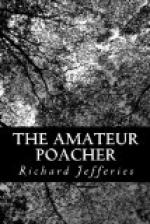There is a way of fishing with rod and line, but without a bait. The rod should be in one piece, or else a stout one—the line also very strong and short, the hook of large size. When the fish is discovered the hook is quietly dropped into the water and allowed to float, in seeming, along, till close under it. The rod is then jerked up, and the barb enters the body of the fish and drags it out.
This plan requires, of course, that the fish should be visible, and if stationary is more easily practised; but it is also effective even against small fish that swim together in large shoals, for if the hook misses one it strikes another. The most fatal time for fish is when they spawn: roach, jack, and trout alike are then within reach, and if the poacher dares to visit the water he is certain of a haul.
Even in the present day and in the south a fawn is now and then stolen from parks and forests where deer are kept. Being small, it is not much more difficult to hide than a couple of hares; and once in the carrier’s cart and at a little distance no one asks any questions. Such game always finds a ready sale; and when a savoury dish is on the table those who are about to eat it do not inquire whence it came any more than the old folk did centuries ago. A nod and a wink are the best sauce. As the keepers are allowed to sell a certain number of fawns (or say they are), it is not possible for any one at a distance to know whether the game was poached or not. An ordinary single-barrel muzzle-loader of the commonest kind with a charge of common shot will kill a fawn.
I once started to stalk a pheasant that was feeding in the corner of a meadow. Beyond the meadow there was a cornfield which extended across to a preserved wood. But the open stubble afforded no cover—any one walking in it could be seen—so that the pheasant had to be got at from one side only. It was necessary also that he should be shot dead without fluttering of wings, the wood being so near.
The afternoon sun, shining in a cloudless sky—it was a still October day—beat hot against the western side of the hedge as I noiselessly walked beside it. In the aftermath, green but flowerless, a small flock of sheep were feeding—one with a long briar clinging to his wool. They moved slowly before me; a thing I wanted; for behind sheep almost any game can be approached.
I have also frequently shot rabbits that were out feeding, by the aid of a herd of cows. It does not seem to be so much the actual cover as the scent of the animals; for a man of course can be seen over sheep, and under the legs of cattle. But the breath and odour of sheep or cows prevent the game from scenting him, and, what is equally effective, the cattle, to which they are accustomed, throw them off their guard.
The cart-horses in the fields do not answer so well: if you try to use one for stalking, unless he knows you he will sheer off and set up a clumsy gallop, being afraid of capture and a return to work. But cows will feed steadily in front, and a flock of sheep, very slowly driven, move on with a gentle ‘tinkle, tinkle.’ Wild creatures show no fear of what they are accustomed to, and the use of which they understand.




